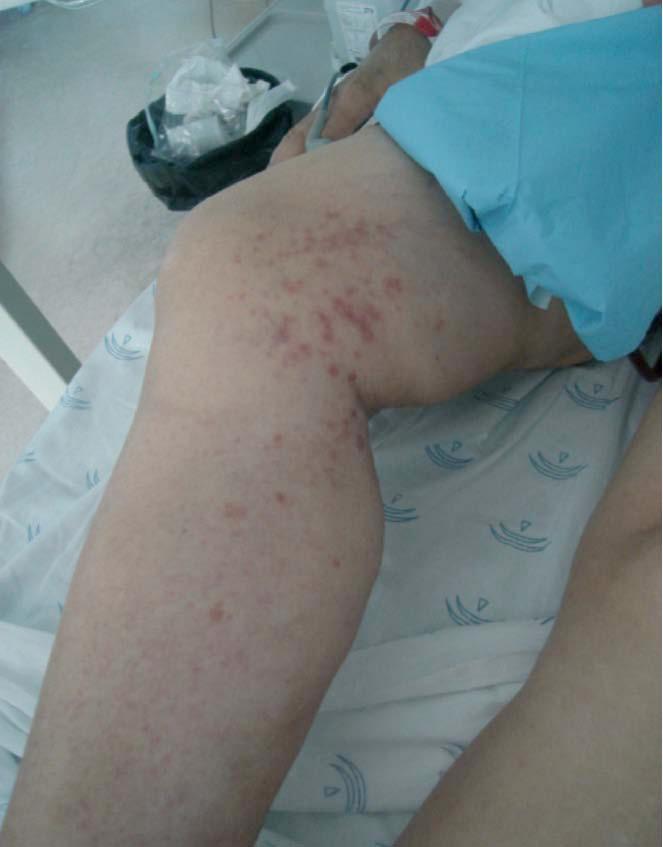Dear Editor,
Hepatitis C virus infection (HCV) is associated with cryoglobulinaemia1, mainly mixed type II, associated or not with membrane-proliferative glomerulonephritis. The prevalence of cases with clinical symptoms is 1:1,000,000, but 40-60% of the patients with HCV have elevated cryoglobulins. In transplant patients, who were previously HCV positive,2-4 this is an important cause of de novo glomerulonephritis. In these patients the prevalence of cryoglobulinaemia after transplant is 2.7-45%.
We present a case of a 63 year old patient with renal failure due to postpartum cortical necrosis, on haemodialysis since 1980. She was HCV positive. In a liver biopsy performed in 1986 slight chronic portal and lobular inflammation without any signs of activity were seen, since then there has been ALT elevation 2-3fold.
The patient underwent her first transplant in 1992, and lost graft function due to glomerulopathy of the transplant in 1996. The second transplant was performed in 2001. The patient received immunosuppression with mofetil mycophenolate, tacrolimus and steroids. The patient had a maximum panel reactive antibody (PRA) prior to transplant of 52%, which decreased to 0% during the months prior to transplant surgery. Plasma creatinine was stable (1.5-1.7 mg/dl), proteinuria positive and less than 500 mg/24 hours. In January 2007 prednisone was discontinued, with a subsequent increase of proteinuria that reached nephrotic proportions in January 2009. The HCV viral load was persistently positive.
The patient is admitted in February 2009 to Pneumology due to non-condensing respiratory infection and stable renal function. Clinical symptoms improve on antibiotic therapy. One week later the patient presents arthromyalgia, fever, oedemas and petechial lesions in lower limbs (Figure 1). The patient presents progressive deterioration with dyspnoea, leukocytosis, anaemia and creatinine rise (4 mg/dl), requiring therefore haemodialysis due to oligoanuria.
We ruled out haemolytic-uremic syndrome (peripheral blood smear with no schistocytes, normal platelet count, and absence of severe hypertension). ANCA and anti-GBM were negative, ruling out these causes of secondary rapidly progressive renal failure. The patient was positive to plasma cryoglobulins (30%), complements (C4 <2; C3 111) and rheumatoid factor (positive; 408 U/l). The HCV viral load was 31,263,906 copies/ml, genotype 1. Renal biopsy showed changes compatible with cryoglobulinaemic membrane-proliferative glomerulonephritis, glomeruli with a proliferative membrane pattern, cell proliferation and hyaline thrombi. With a diagnosis of membrane proliferative glomerulonephritis associated with HCV, treatment with plasmapheresis was begun, causing reversion of skin and lung lesions, but the patient remained dialysis-dependent. Given the advanced renal failure, treatment with pegylated interferon and ribavarin was begun, and haemoglobin was closely monitored. Four months later the viral load was undetectable.
HCV treatment was chosen, with pegylated interferon and ribavarin,1,3,5 but in patients with renal failure, creatinine clearance must be monitored. According to the levels of creatinine clearance, ribavarin and/or pegylated interferon may not be advisable or it may be necessary to monitor haemoglobin levels. In cases in which this occurs plasmapheresis may be used or drugs such as rituximab3 used for (renal, neurological or skin) exacerbations. Once overcome, antiviral drugs will be administered. Furthermore, pegylated interferon is contraindicated in patients that have undergone transplant,5 but in our case the patient had already returned to dialysis.
In our patient we blamed the persistent proteinuria on possible chronic changes, although it may have been related to cryoglobulinaemia. We would like to highlight the importance of keeping this possibility in mind, since this condition is quite frequent with a subclinical presentation and can lead to kidney transplant failure.2
Figure 1. Vasculitis skin lesions








